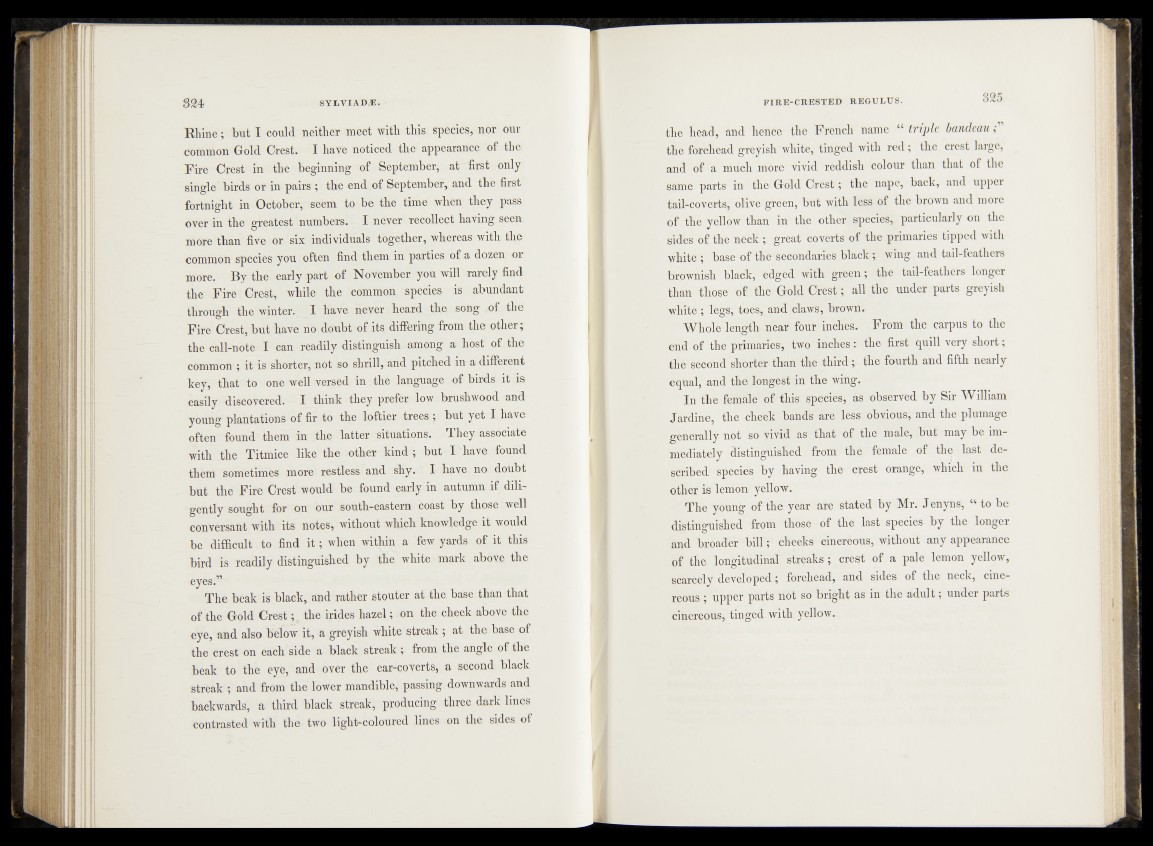
Rhine; but I could neither meet with this species, nor our
common Gold Crest. I have noticed the appearance of the
Fire Crest in the beginning of September, at first only
single birds or in pairs ; the end of September, and the first
fortnight in October, seem to be the time when they pass
over in the greatest numbers. I never recollect having seen
more than five or six individuals together, whereas with the
common species you often find them in parties of a dozen or
more. By the early part of November you will rarely find
the Fire Crest, while the common species is abundant
through the winter. I have never heard the song of the
Fire Crest, but have no doubt of its differing from the other;
the call-note I can readily distinguish among a host of the
common ; it is shorter, not so shrill, and pitched in a different
key, that to one well versed in the language of birds it is
easily discovered. I think they prefer low brushwood and
young plantations of fir to the loftier trees ; but yet I have
often found them in the latter situations. They associate
with the Titmice like the other kind; but I have found
them sometimes more restless and shy. I have no doubt
but the Fire Crest would be found early in autumn if diligently
sought for on our south-eastern coast by those well
conversant with its notes, without which knowledge it would
be difficult to find i t ; when within a few yards of it this
bird is readily distinguished by the white mark above the
eyes.”
The beak is black, and rather stouter at the base than that
of the Gold Crest; the irides hazel; on the cheek above the
eye, and also below it, a greyish white streak ; at the base of
the crest on each side a black streak ; from the angle of the
beak to the eye, and over the ear-coverts, a second black
streak ; and from the lower mandible, passing downwards and
backwards, a third black streak, producing three dark lines
contrasted with the two light-coloured lines on the sides of
the head, and hence the French name “ triple bandeau;
the forehead greyish white, tinged with re d ; the crest large,
and of a much more vivid reddish colour than that of the
same parts in the Gold Crest; the nape, back, and upper
tail-coverts, olive green, but with less of the brown and more
of the yellow than in the other species, particularly on the
sides of the neck ; great coverts of the primaries tipped with
white ; base of the secondaries black; wing and tail-feathers
brownish black, edged with green; the tail-feathers longer
than those of the Gold Crest; all the under parts greyish
white ; legs, toes, and claws, brown.
Whole length near four inches. From the carpus to the
end of the primaries, two inches: the first quill very short;
the second shorter than the third ; the fourth and fifth nearly
equal, and the longest in the wing.
In the female of this species, as observed by Sir William
Jardine, the cheek bands are less obvious, and the plumage
generally not so vivid as that of the male, but may be immediately
distinguished from the female of the last described
species by having the crest orange, which in the
other is lemon yellow.
The young of the year are stated by Mr. Jenyns, “ to be
distinguished from those of the last species by the longer
and broader b ill; cheeks cinereous, without any appearance
of the longitudinal streaks ; crest of a pale lemon yellow,
scarcely developed; forehead, and sides of the neck, cinereous
; upper parts not so bright as in the adult; under parts
cinereous, tinged with yellow.